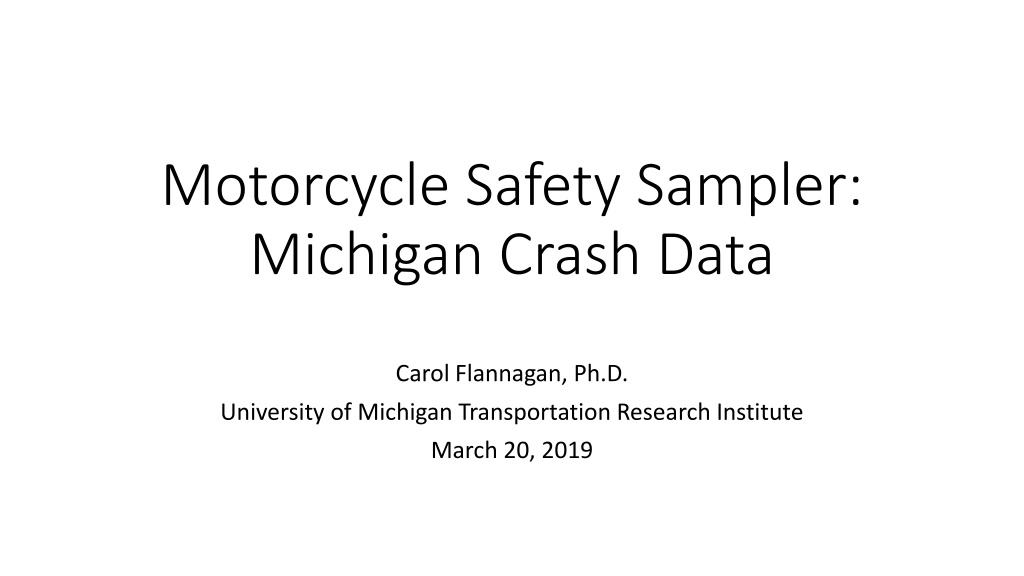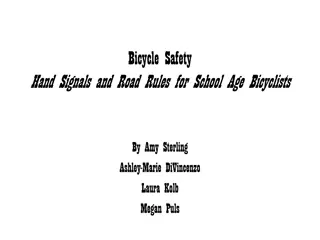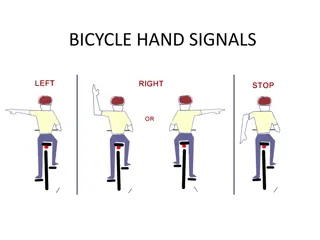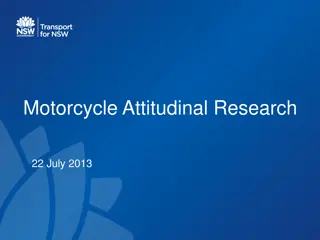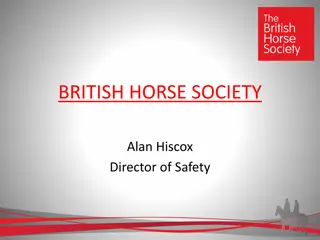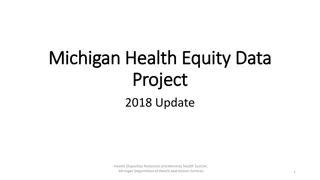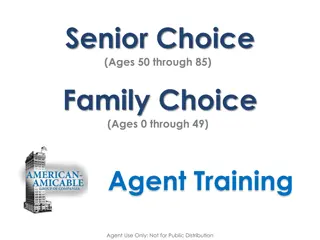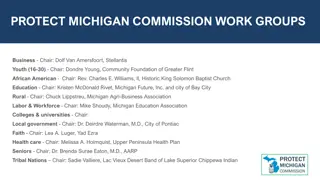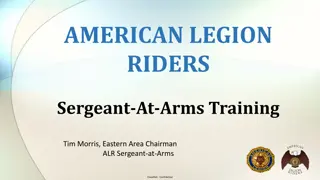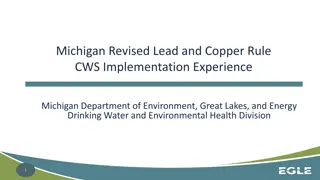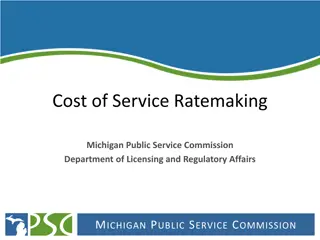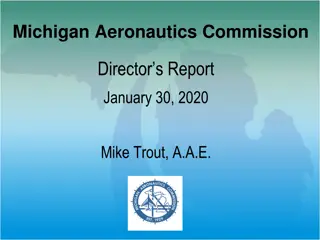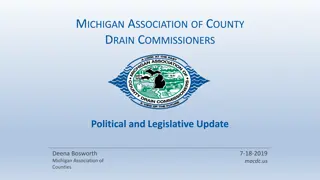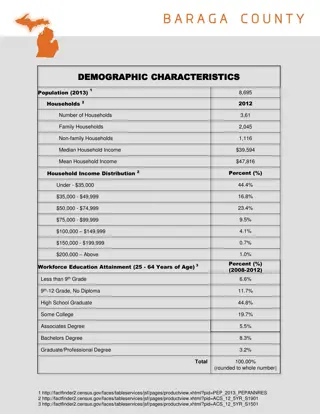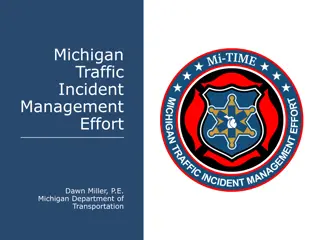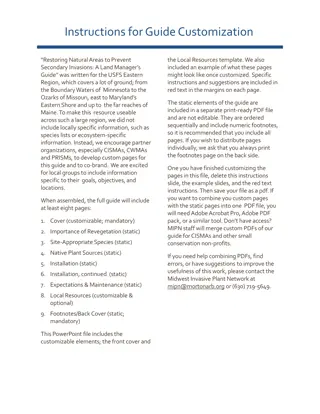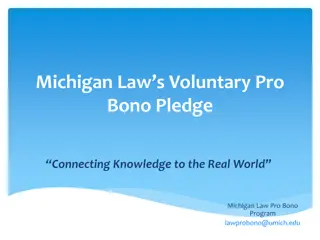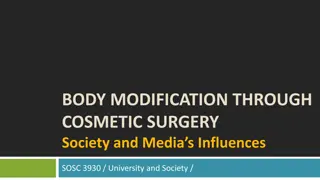Motorcycle Helmet Law Modification in Michigan: Impact on Riders' Safety
Study on motorcycle crashes in Michigan after helmet law modification in 2012 reveals a decline in helmet use rates and a subsequent rise in fatalities and serious injuries. Despite stable trends in non-resident involvement, younger riders showed decreased helmet compliance. Not wearing helmets increased fatality and serious injury risks, emphasizing the importance of helmet laws for motorcycle safety.
Download Presentation

Please find below an Image/Link to download the presentation.
The content on the website is provided AS IS for your information and personal use only. It may not be sold, licensed, or shared on other websites without obtaining consent from the author. Download presentation by click this link. If you encounter any issues during the download, it is possible that the publisher has removed the file from their server.
E N D
Presentation Transcript
Motorcycle Safety Sampler: Michigan Crash Data Carol Flannagan, Ph.D. University of Michigan Transportation Research Institute March 20, 2019
Motorcycle Crashes and the Helmet Law Helmet law was modified starting April 13, 2012 Helmets no longer required for motorcyclists age 21+ Six years of data now what can we learn/conclude?
Title Key results: In the crash population, helmet use dropped from 98% in 2008-2011 to 74% in 2012 after modification of the helmet law. The rate was just below 70% in 2017. In general, the helmet use rate observed in crashes has been decreasing very slowly since the large decrease after the modification. Before and after the modification, the percentage of out-of-state riders who were involved in Michigan crashes has remained stable at ~6%. Helmet use rates for crash-involved riders age 16-20 dropped from 96% before the modification to 83% in 2017, even though helmet use is mandatory for the riders in this age group. Motorcycle drivers without motorcycle endorsements are somewhat less likely to wear a helmet, compared to those with endorsements. Those with endorsements made up 55% of the population both before and after the modification. After accounting for other risk factors (e.g., alcohol involvement), the risk of fatality for non-helmeted riders was 1.9 times the risk for helmeted riders. Non-helmeted riders risk of serious injury was 1.7 times higher than that of helmeted riders. The overall rate of K+A injuries (per crash-involved rider) decreased from 21% before the modification to 18% after. However, the fatality rate per crash-involved rider increased from just over 3% in 2010-2011 to just over 4% in 2015-2017. Regression models were used to estimate the number of fatalities and serious injuries attributable to changes in helmet use since the modification. Based on these models, 19% (23 per year) of fatalities and 12% (77 per year) of serious injuries were estimated to have resulted from reduced helmet use after the helmet-law modification.
Basic trends: Helmet Use April 13, 2012 Motorcycle helmet law modification in effect
Basic trends: Fatalities April 13, 2012 Motorcycle helmet law modification in effect
Breakdown by Group Helmet Use Group Before Modification After Modification Gender (after only) Males Females <16 16-20 21+ Driver Passenger Michigan Other Yes No 97.4% 97.6% 92.1% 96.5% 97.7% 97.4% 97.6% 97.6% 95.0% 98.7% 96.3% 68.6% 71.3% 77.0% 82.1% 68.8% 69.9% 65.2% 69.8% 62.2% 72.8% 64.3% Age (yrs)* Seat Position Vehicle Registration State* License Endorsement*
Risk factors With motorcycles (among others), risk factors go together: Alcohol Not wearing helmets Speeding
Risk factors Helmet Use Alcohol Presence Before Modification After Modification Yes 89.2% 42.5% No 98.1% 72.9%
Risk factors Fatality Rate (per Crash) Helmet Use Before Modification After Modification 3.40% 2.83% Yes 6.05% 6.43% No Alcohol moved from mostly here: To mostly here:
How to think about risk factors Wearing a helmet cuts risk of fatality in half, all other things being equal BUT, fatalities have not skyrocketed (or even increased by 25%) since the modification Risky motorcyclists (alcohol and speeding) in fatal crashes may have died anyway even when wearing a helmet (because of the severity of the crash) But, other states see continuing decline in helmet use over time, and increase in fatalities is happening now and probably will continue
Recommendations Promote endorsements Continued efforts to reduce drunk cycling Promote helmet use for drivers <21 (and recommended for others)
